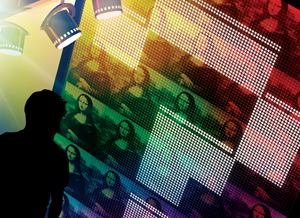COLOR RENDERING IS THE DIFFERENCE
Generally, the more light-sensitive the exhibit, the lower the light level a designer can use. In fact, it must be remembered that the 50-lux level was set on the basis of it being the lowest level at which the majority of people can perceive full color under incandescent light with a color rendering index of near 100.
Most lighting designers will have experienced exhibits lit to this level with fluorescent lamps, and will have noted the flat rendition and difficulty in differentiating color. Also, it is not uncommon to see this in the gloom of overly dimmed incandescent lamps. But it is possible to achieve bright and colorful displays with properly selected and installed low-voltage tungsten halogen at low-light levels.
Unfortunately, LEDs have more in common with the fluorescent lamp spectrum than the incandescent. White-light LEDs are usually made from combining a blue LED and a yellow phosphor. This produces peak outputs in blue and yellow with distinct fall-off in cyan and red output. The latter is of most concern from a lighting perspective. The lack of red, particularly compared to the red-rich incandescent lamp, results in poor rendering of warm tones, including skin tones. On the other hand, the peak in blue causes concerns for damage to light-sensitive objects. Designers and conservators are well aware that ultraviolet (UV) light is damaging and it is routinely filtered out before it comes into contact with an artwork.
Light is also more destructive the further it moves toward blue in the color spectrum. This concern has become the subject of a discussion led by Dale Kronkright, head of conservation at the Georgia O’Keeffe Museum in Santa Fe, N.M., (see sidebar at left). It is also the subject of an interesting paper “Color Degradation of Textiles with Natural Dyes and of Blue Scale Standards Exposed to White LED Lamps: Evaluation of White LED Lamps for Effectiveness as Museum Lighting” (Mie ISHII et al, Journal of Light & Visual Environment Vol. 32, No. 4, 2008). If we adopt LED technology, we could reduce the quality of light in a way that challenges some of the working norms in lighting museum objects.
The next question is, “Will LEDs ever provide a satisfactory color rendering?” The answer is a qualified “Yes.” There are already products on the market that achieve the quality of color rendering close to that which lighting designers are accustomed, such as the Xicato’s Artists Series. The only problem with modules like these is that their energy efficiency is not a great deal better than the best tungsten halogen lamps. Manufacturers promise efficiency improvements, but high-quality color rendering will come at a significant cost in energy usage.
This is not a new situation. We have had the option of high color-rendering fluorescent lamps for many years, but their energy efficiency is significantly below the efficiency of normal fluorescent lamps that have color rendering index in the 80s. These lamps typically produce 113 Lm/W for a color 85 lamp but only 75 Lm/W for a color 90 lamp. Realistically, fluorescent remains a more efficient light source than an LED but does not do the same job.
OPTICAL CONTROL
Another issue to consider with LEDs is optical control. At the moment, LED lightsources are configured in three different ways. First, there are individual LEDs used in groups to achieve the necessary light levels, with each LED having its own phosphors to create white and optics to control the beam and field angle. This system generally works well, but it is difficult to ensure good color consistency between different LEDs.
The second system is a group of LEDs behind a common phosphor. This allows for finer tuning of color, better color consistency, and better light-output consistency between devices. The downside of this arrangement is that you end up with a relatively large light source, typically 20mm (3/4 inch) in diameter. This causes problems with optics that require a large-diameter reflector or lens to capture the light and focus it into the required beam angle, resulting in larger fixtures than what we are used to. It also results in a wide field angle that scatters light, which is a problem when you are trying to achieve a tightly focused exhibition.
Finally, the third system uses very small chips behind a single optic. This is the approach taken by Cree, and it produces a tight control of color. (I have not experimented with these, so I don’t know how well the optics deliver a tight, controlled, uniform beam pattern.)
In my opinion, we do not yet have a good LED solution for museum lighting to replace the best low-voltage tungsten halogen lamps, and limitations in the technology may prevent us from getting there. Any lighting system that creates a discontinuous, nonlinear spectrum will always have issues with rendering color. Attempts to solve these problems erodes the raw efficiency of the LED. We might have to accept a loss of lighting quality in museums over the next decade in order to reduce our energy use by changing light-source technology to higher efficiency light sources.
Our other solution would be to reduce light exposure to objects, more comprehensive lighting control strategies, and limit the time objects are illuminated.
Museum lighting has always been about balancing incompatible requirements. New technologies and requirements are not making the designer’s task any easier, and we have to educate our clients so that they understand the reason behind our decisions, and accept their share of responsibility for the presentation and conservation of our cultural heritage.
Kevan Shaw, an independent lighting designer who has been working in museum lighting for 20 years, is director of sustainability of the Professional Lighting Designers’ Association and chairman of the working group revisiting Lighting Guide 8, Museum and Gallery Lighting for the Society of Light and Lighting in the U.K.
